Evidence of Ejecta from the Late-Triassic Manicouagan Impact in the Blomidon Formation, Fundy Basin, Canada
Abstract
1. Introduction
2. Materials and Methods
2.1. Setting and Stratigraphy
2.2. Previous Work
2.3. Analytical Methods
3. Results
3.1. Shocked Grains
3.2. Other Grain Types
4. Discussion
4.1. Scarcity of PDFs
4.2. Ejecta Reworking
4.3. Trigger of Seismicity
4.4. Magnetostratigraphic Implications
5. Conclusions
Author Contributions
Funding
Data Availability Statement
Acknowledgments
Conflicts of Interest
Abbreviations
| ID-TIMS | isotope dilution thermal ionization mass spectrometry |
| CA-ID-TIMS | chemical abrasion isotope dilution thermal ionization mass spectrometry |
| K-Pg | Cretaceous-Paleogene boundary |
| PGE | Platinum group elements |
| PDFs | Planar deformation features |
| AGC | Accreted grain clusters |
| MFZ | Minas Fault Zone |
| CCS | Clastic cored spherules |
| SEM | Scanning electron microscopy |
| APTS | Astrochronostratigraphic Polarity Time Scale |
| GPTS | Global Paleomagnetic Time Scale |
References
- O’Connell-Cooper, C.D.; Spray, J.G. Geochemistry of the Manicouagan Impact melt sheet. In Proceedings of the 41st Lunar and Planetary Science Conference, The Woodlands, TX, USA, 1–5 March 2010. [Google Scholar]
- Grieve, R.A.; Head, J. W, III. The Manicouagan impact structure: An analysis of its original dimensions and form. J. Geophys. Res. Solid Earth 1983, 88, A807–A818. [Google Scholar] [CrossRef]
- Spray, J.G.; Thompson, L.M.; Biren, M.B.; O’Connell-Cooper, C.D. The Manicouagan impact structure as a terrestrial ana-logue site for lunar and Martian planetary science. Planet. Space Sci. 2010, 58, 538–551. [Google Scholar] [CrossRef]
- Thompson, L.M.; Spray, J.G. The Manicouagan impact research program, and other Canadian impact crater studies. In Proceedings of the 76th Annual Meeting of the Meteoritical Society, Edmonton, AB, Canada, 29 July–2 August 2013. [Google Scholar]
- Brown, J.J.; Spray, J.G.; Thompson, L.M. Shock Attenuation within the Manicouagan Impact Structure. In Proceedings of the 47th Lunar and Plan-Etary Science Conference, The Woodlands, TX, USA, 21–25 March 2016. [Google Scholar]
- Clutson, M.J.; Brown, D.E.; Tanner, L.H. Distal processes and effects of multiple Late Triassic terrestrial bolide impacts: Insights from the Norian Manicouagan event, northeastern Quebec, Canada. In The Late Triassic World; Tanner, L.H., Ed.; Springer: Cham, Switzerland, 2018; pp. 127–187. [Google Scholar]
- Olsen, P.E.; Shubin, N.H.; Anders, M.H. New Early Jurassic tetrapod assemblages constrain Triassic-Jurassic tetrapod extinction event. Science 1987, 237, 1025–1029. [Google Scholar] [CrossRef] [PubMed]
- Olsen, P.E.; Kent, D.V.; Sues, H.D.; Koeberl, C.; Huber, H.; Montanari, A.; Rainforth, E.C.; Fowell, S.J.; Szajna, M.J.; Hartline, B.W. Ascent of dinosaurs linked to an iridium anomaly at the Triassic-Jurassic boundary. Science 2002, 296, 1305–1307. [Google Scholar] [CrossRef] [PubMed]
- Olsen, P.E.; Koeberl, C.; Huber, H.; Montanari, A.; Fowell, S.; Et-Touhami, M.; Kent, D.V. The continental Triassic–Jurassic boundary in central Pangea: Recent progress and preliminary report of an Ir anomaly. In Catastrophic Events and Mass Extinctions: Impacts and Beyond; Koeberl, C., MacLeod, K.G., Eds.; Geological Society of America Special Paper 356; Geological Society of America: Boulder, CO, USA, 2002; pp. 505–522. [Google Scholar]
- Hodych, J.P.; Dunning, G.R. Did the Manicouagan impact trigger end-of-Triassic mass extinctions? Geology 1992, 20, 51–54. [Google Scholar] [CrossRef]
- Ramezani, J.; Bowring, S.A.; Pringle, M.S.; Winslow, F.D., III; Rasbury, E.T. The Manicouagan impact melt rock: A proposed standard for the intercalibration of U-Pb and 40Ar/39Ar isotopic systems. Geochim. Cosmochim. Acta 2005, 69, 321. [Google Scholar]
- van Soest, M.C.; Hodges, K.V.; Wartho, J.A.; Biren, M.B.; Monteleone, B.D.; Ramezani, J.; Spray, J.G.; Thompson, L.M. (U–Th)/He dating of terrestrial impact structures: The Manicouagan example. Geochem. Geophys. Geosyst. 2011, 12, 1–8. [Google Scholar] [CrossRef]
- Biren, M.B.; van Soest, M.; Wartho, J.-A.; Spray, J.G. Dating the cooling of exhumed central uplifts of impact structures by the (U-Th)/He method: A case study at Manicouagan. Chem. Geol. 2014, 377, 56–71. [Google Scholar] [CrossRef]
- Jaret, S.J.; Hemming, S.R.; Rasbury, E.T.; Thompson, L.M.; Glotch, T.D.; Ramezani, J.; Spray, J.G. Context Matters—Ar-Ar Results from in and around the Manicouagan Impact Structure: Implications for Martian Meteorite Chronology. Earth Planet. Sci. Lett. 2018, 501, 78–89. [Google Scholar] [CrossRef]
- Kent, D.V.; Olsen, P.E.; Muttoni, G. Astrochronostratigraphy polarity time scale (APTS) for the Late Triassic and Early Jurassic from continental sediments and correlation with standard marine stages. Earth Sci. Rev. 2017, 166, 153–180. [Google Scholar] [CrossRef]
- Onoue, T.; Sato, H.; Nakamura, T.; Noguchi, T.; Hidaka, Y.; Shiraid, N.; Ebihara, M.; Osawa, T.; Hatsukawa, Y.; Toh, Y.; et al. Deepsea record of impact apparently unrelated to mass extinction in the Late Triassic. Proc. Natl. Acad. Sci. USA 2012, 109, 19134–19139. [Google Scholar] [CrossRef]
- Parker, W.J.; Martz, J.W. The Late Triassic (Norian) Adamanian–Revueltian tetrapod faunal transition in the Chinle Formation of Petrified Forest National Park, Arizona. Earth Environ. Sci. Trans. R. Soc. Edinb. 2011, 101, 231–260. [Google Scholar] [CrossRef]
- Sato, H.; Onoue, T.; Nozaki, T.; Suzuki, K. Osmium isotope evidence for a large Late Triassic impact event. Nat. Commun. 2013, 4, 2455. [Google Scholar] [CrossRef]
- Sato, H.; Shirai, N.; Ebihara, M.; Onoue, T.; Kiyokawa, S. Sedimentary PGE signatures in the Late Triassic ejecta deposits from Japan: Implications for the identification of impactor. Paleogeogr. Palaeoclim. Palaeoecol. 2016, 442, 36–47. [Google Scholar] [CrossRef]
- Uno, K.; Yamashita, D.; Onoue, T.; Uehara, D. Paleomagnetism of Triassic bedded chert from Japan for determining the age of an impact ejecta layer deposited on peri-equatorial latitudes of the paleo-Pacific Ocean: A preliminary analysis. Phys. Earth Planet. Inter. 2015, 249, 59–67. [Google Scholar] [CrossRef]
- Kirkham, A. Triassic microtektite pseudomorphs of the Bristol area. Geoscient 2002, 12, 17–18. [Google Scholar]
- Kirkham, A. Glauconitic spherules from the Triassic of the Bristol area, S.W. England: Probable microtektite pseudomorphs. Proc. Geol. Assoc. 2003, 114, 11–21. [Google Scholar] [CrossRef]
- Kirkham, A. Triassic Meteorite Impact? Mag. Geol. Assoc. 2006, 5, 21. [Google Scholar]
- Walkden, G.; Parker, J.; Kelley, S. A Late Triassic impact ejecta layer in southwestern Britain. Science 2002, 298, 2185–2188. [Google Scholar] [CrossRef] [PubMed]
- Thackrey, S.; Walkden, G.; Kelley, S.; Parrish, R.; Horstwood, M.; Indares, A.; Stills, J.; Spray, J. Determining source of ejecta using heavy mineral provenance techniques; A Manicouagan distal ejecta case study. In Proceedings of the 39th Lunar and Planetary Science Conference, League City, TX, USA, 10–14 March 2008. Abst.1254. [Google Scholar]
- Thackrey, S.; Walkden, G.; Indares, A.; Horstwood, A.; Kelley, S.; Parrish, R. The use of heavy mineral correlation for deter-mining the source of impact ejecta: A Manicouagan distal ejecta case study. Earth Planet. Sci. Lett. 2009, 285, 163–172. [Google Scholar] [CrossRef]
- Jaret, S.J.; Hesselbo, S.P.; Rasbury, E.T.; Ebel, D.S. Petrography and Provenance of Triassic Impact Ejecta from SW England, United Kingdom. In Proceedings of the 51st Lunar and Planetary Science Conference, The Woodlands, TX, USA, 16–20 March 2020. Abstr. 2389. [Google Scholar]
- McGregor, M.; Spray, J.G.; McFarlane, C.R. Provenance constraints on the Late Triassic ejecta layer from Churchwood Quar-ry, SW England: An impactite suite from Manicouagan. Meteorit. Planet. Sci. 2024, 59, 1632–1657. [Google Scholar] [CrossRef]
- Tanner, L.H. Synsedimentary seismic deformation in the Blomidon Formation (Norian-Hettangian), Fundy basin, Canada. New Mex. Mus. Nat. Hist. Sci. Bull. 2006, 37, 35–42. [Google Scholar]
- Olsen, P.E.; Schlische, R.W. Transtensional arm of the early Mesozoic Fundy rift basin: Penecontemporaneous faulting and sedimentation. Geology 1990, 18, 695–698. [Google Scholar] [CrossRef]
- Wade, J.A.; Brown, D.E.; Fensome, R.A.; Traverse, A. The Triassic-Jurassic Fundy Basin, Eastern Canada: Regional setting, stratigraphy and hydrocarbon potential. Atl. Geol. 1996, 32, 189–231. [Google Scholar] [CrossRef]
- Sues, H.D.; Olsen, P.E. Stratigraphic and temporal context and faunal diversity of Permian-Jurassic continental tetrapod as-semblages from the Fundy rift basin, eastern Canada. Atl. Geol. 2015, 51, 139–205. [Google Scholar] [CrossRef]
- Tanner, L.H. Triassic-Jurassic lacustrine deposition in the Fundy rift basin, eastern Canada. In Lake Basins Through Space and Time; Gierlowski-Kordesch, E.H., Kelts, K.R., Eds.; American Association of Petroleum Geologists Studies in Geology; American Association of Petroleum Geologists (AAPG): Tulsa, OK, USA, 2000; Volume 46, pp. 159–166. [Google Scholar]
- Ackermann, R.V.; Schlische, R.W.; Olsen, P.E. Synsedimentary collapse of portions of the lower Blomidon Formation (Late Triassic), Fundy rift basin, Nova Scotia. Can. J. Earth Sci. 1995, 32, 1965–1976. [Google Scholar] [CrossRef]
- Tanner, L.H. Pedogenic record of paleoclimate and basin evolution in the Triassic-Jurassic Fundy rift basin, eastern Canada. In Aspects of Triassic-Jurassic Rift Basin Geoscience; LeTourneau, P., Olsen, P.E., Eds.; Columbia University Press: New York, NY, USA, 2003; pp. 108–122. [Google Scholar]
- Kent, D.V.; Olsen, P.E. Magnetic polarity stratigraphy and paleolatitude of the Triassic-Jurassic Blomidon Formation in the Fundy basin (Canada): Implications for early Mesozoic tropical climate gradients. Earth Planet. Sci. Lett. 2000, 179, 311–324. [Google Scholar] [CrossRef]
- Fowell, S.J.; Traverse, A. Palynology and age of the upper Blomidon Formation, Fundy basin, Nova Scotia. Rev. Palaeobot. Pal-Ynol 1995, 86, 211–233. [Google Scholar] [CrossRef]
- Cirilli, S.; Marzoli, A.; Tanner, L.H.; Bertrand, H.; Buratti, N.; Jourdan, F.; Bellieni, G.; Kontak, D.; Renne, R.P. The onset of CAMP eruptive activity and the Tr-J boundary: Stratigraphic constraints from the Fundy Basin, Nova Scotia. Earth Planet. Sci. Lett. 2009, 286, 514–525. [Google Scholar] [CrossRef]
- Toon, O.B.; Sahnle, K.; Morrizon, D.; Turco, R.P.; Covey, C. Environmental perturbations caused by the impacts of asteroids and comets. Rev. Geophys. 1997, 35, 41–78. [Google Scholar] [CrossRef]
- Boslough, M.E.; Chael, E.P.; Trucano, T.G.; Crawford, D.A.; Campbell, D.L. Axial focusing of impact energy in the Earth’s interior: A possible link to flood basalts and hotspots. In The Cretaceous-Tertiary Event and Other Catastrophes in Earth History; Geological Society of America Special Paper 307; Geological Society of America: Boulder, CO, USA, 1996; pp. 541–550. [Google Scholar]
- Therriault, A.M. (Earth Sciences Sector, Natural Resources Canada, Ottawa, ON, Canada). Personal communication, 2003.
- Kyte, F.T. (Center for Astrobiology, Institute of Geophysics and Planetary Physics, University of California, Los Angeles, CA, USA); Becker, L. (Department of Earth and Space Sciences, University of Washington, Seattle, WA, USA); Wohlbach, W. (Department of Chemistry, DePaul University, Chicago, IL, USA). Personal communication, 2003.
- Gratz, A.J.; Fisler, D.K.; Bohor, B.F. Distinguishing shocked from tectonically deformed quartz by the use of SEM and chem-ical etching. Earth Planet. Sci. Lett. 1996, 142, 513–521. [Google Scholar] [CrossRef]
- French, B.M.; Koeberl, C. The convincing identification of terrestrial meteorite impact structures: What works, what doesn’t, and why. Earth-Sci. Rev. 2010, 98, 123–170. [Google Scholar] [CrossRef]
- Mossman, D.J.; Grantham, R.G.; Langenhorst, F. A search for shocked quartz at the Triassic-Jurassic boundary in the Newark basins of the Newark Supergroup. Can. J. Earth Sci. 1998, 35, 101–109. [Google Scholar] [CrossRef]
- Grieve, R.A.F. Extraterrestrial impacts on earth: The evidence and the Consequences. In Meteorites: Flux with Time and Impact Effects; Grady, M.M., Hutchison, R., McCall, G.J.H., Rothery, D.A., Eds.; Geological Society, London, Special Publications 140; Geological Society: London, UK, 1998; pp. 105–131. [Google Scholar]
- Pickersgill, A.E.; Osinski, G.R.; Flemming, R.L. Shock effects in plagioclase feldspar from the Mistastin Lake impact structure, Canada. Meteor. Planet. Sci. 2015, 50, 1546–1561. [Google Scholar] [CrossRef]
- Trepmann, C.A.; Dellefant, F.; Kaliwoda, M.; Hess, K.U.; Schmahl, W.W.; Hölzl, S. Quartz and cristobalite ballen in impact melt rocks from the Ries impact structure, Germany, formed by dehydration of shock-generated amorphous phases. Meteorit. Planet. Sci. 2020, 55, 2360–2374. [Google Scholar] [CrossRef]
- Zamiatina, D.A.; Zamyatin, D.A.; Mikhalevskii, G.B. Ballen quartz in Jänisjärvi impact melt rock with high concentrations of Fe, Mg, and Al: EPMA, EDS, EBSD, CL, and Raman Spectroscopy. Minerals 2022, 12, 886. [Google Scholar] [CrossRef]
- Osinski, G.R.; Pierazzo, E. Impact cratering: Processes and products. In Impact Cratering:Processes and Products; Osinski, G.R., Pierazzo, E., Eds.; Wiley-Blackwell: Chichester, UK, 2012; pp. 125–145. [Google Scholar]
- Tanner, L.H.; Kyte, F.T.; Walker, A.E. Multiple Ir anomalies in uppermost Triassic to Jurassic-age strata of the Blomidon Formation, Fundy basin, eastern Canada. Earth Planet. Sci. Lett. 2008, 274, 103–111. [Google Scholar] [CrossRef]
- Tanner, L.H.; Kyte, F.T. Anomalous iridium enrichment in sediments at theTriassic-Jurassic boundary, Blomidon Formation, Fundy basin, Canada. Earth Planet. Sci. Lett. 2005, 240, 634–641. [Google Scholar] [CrossRef]
- Marcus, R.; Melosh, H.J.; Collins, G. Earth Impact Effects Program. 2004. Available online: https://impact.ese.ic.ac.uk/ImpactEarth/ImpactEffects/ (accessed on 20 September 2025).
- Mertz, K.A.; Hubert, J.F. Cycles of sandflat sandstone and playa-lacustrine mudstone in the Triassic-Jurassic Blomidon redbeds, Fundy rift basin, Nova Scotia: Implications for tectonic and climatic controls. Can. J. Earth Sci. 1990, 27, 442–451. [Google Scholar]
- Tanner, L.H.; Lucas, S.G.; Brown, D.E.; Clutson, M.J. Paleomagnetic and biostratigraphic cprrelation of the Manicouagan impact: Implications for the Late Triassic time scale. Geol. Soc. Am. Annu. Meet. Abst. Progr. 2025, 55, 389693. [Google Scholar]
- Hounslow, M.W.; Muttoni, G. The geomagnetic polarity timescale for the Triassic: Linkage to stage boundary definitions. In The Triassic Timescale; Geological Society, London, Special Publications: London, UK, 2010; Volume 334, pp. 61–102. [Google Scholar]
- Wu, Q. An integrated study of Upper Triassic Conodont and Radiolarian Biostratigraphy in the Tethyan Realm. Ph.D. Dissertation, Università degli Studi da Padova, Padova, Italy, 2025. [Google Scholar]
- Hounslow, M.W.; Gallois, R. Magnetostratigraphy of the Mercia Mudstone Group (Devon, UK): Implications for regional relationships and chronostratigraphy in the Middle to Late Triassic of Western Europe. J. Geol. Soc. 2023, 180, 4. [Google Scholar] [CrossRef]
- Hounslow, M.W.; Andrews, J.E. Improved chronostratigraphy and fine-tuned timing for Late Triassic palaeoenvironmental changes in SW Britain using coupled magnetic polarity and carbon isotope stratigraphy. Palaeogeogr. Palaeoclimatol. Palaeoecol. 2024, 656, 112579. [Google Scholar] [CrossRef]
- Kozur, H.W.; Weems, R.E. The biostratigraphic importance of conchostracans in the continental Triassic of the northern hemisphere. In The Triassic Timescale; Geological Society, London, Special Publications: London, UK, 2010; pp. 315–417. [Google Scholar]
- Kent, D.V.; Olsen, P.E.; Rasmussen, C.; Lepre, C.; Mundil, R.; Irmis, R.B.; Gehrels, G.E.; Giesler, D.; Geissman, J.W.; Parker, W.G. Empirical evidence for stability of the 405-kiloyear Jupiter–Venus eccentricity cycle over hundreds of millions of years. Proc. Natl. Acad. Sci. USA 2018, 115, 6153–6158. [Google Scholar] [CrossRef] [PubMed]
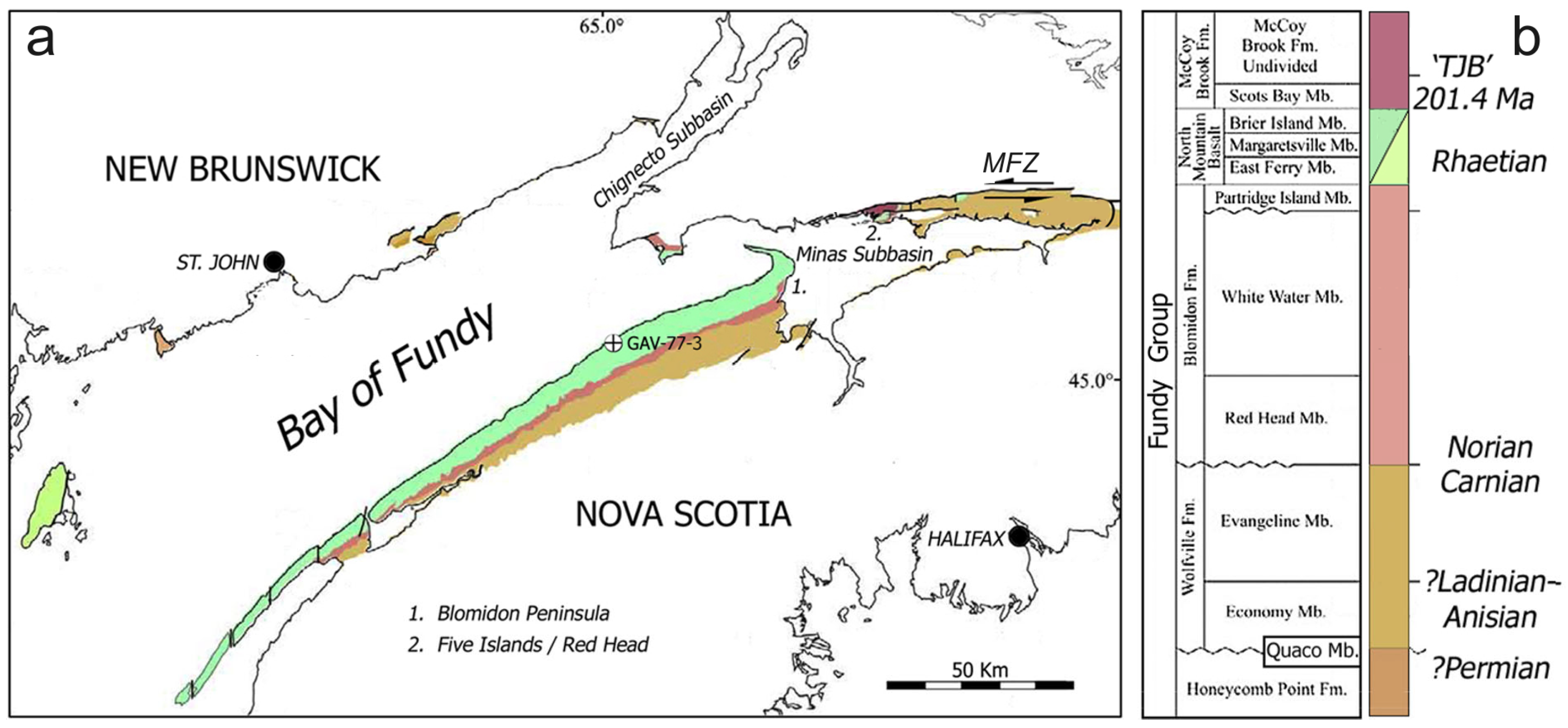
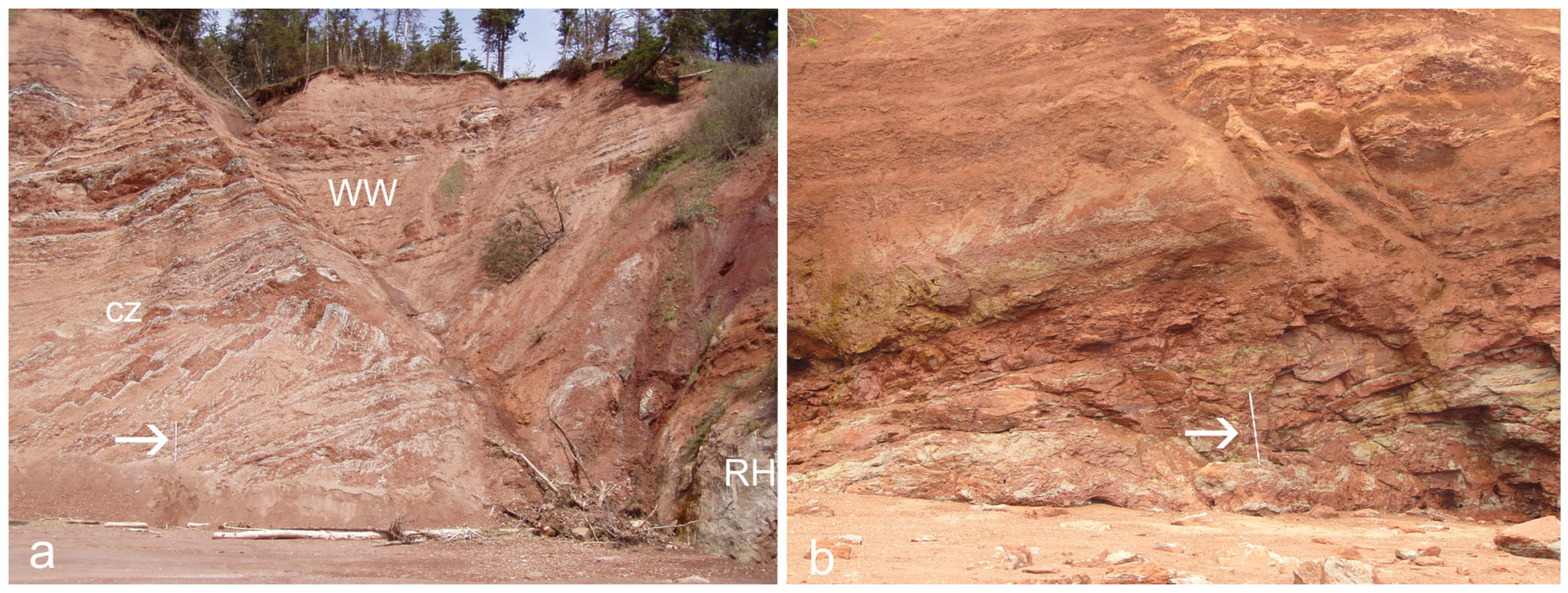
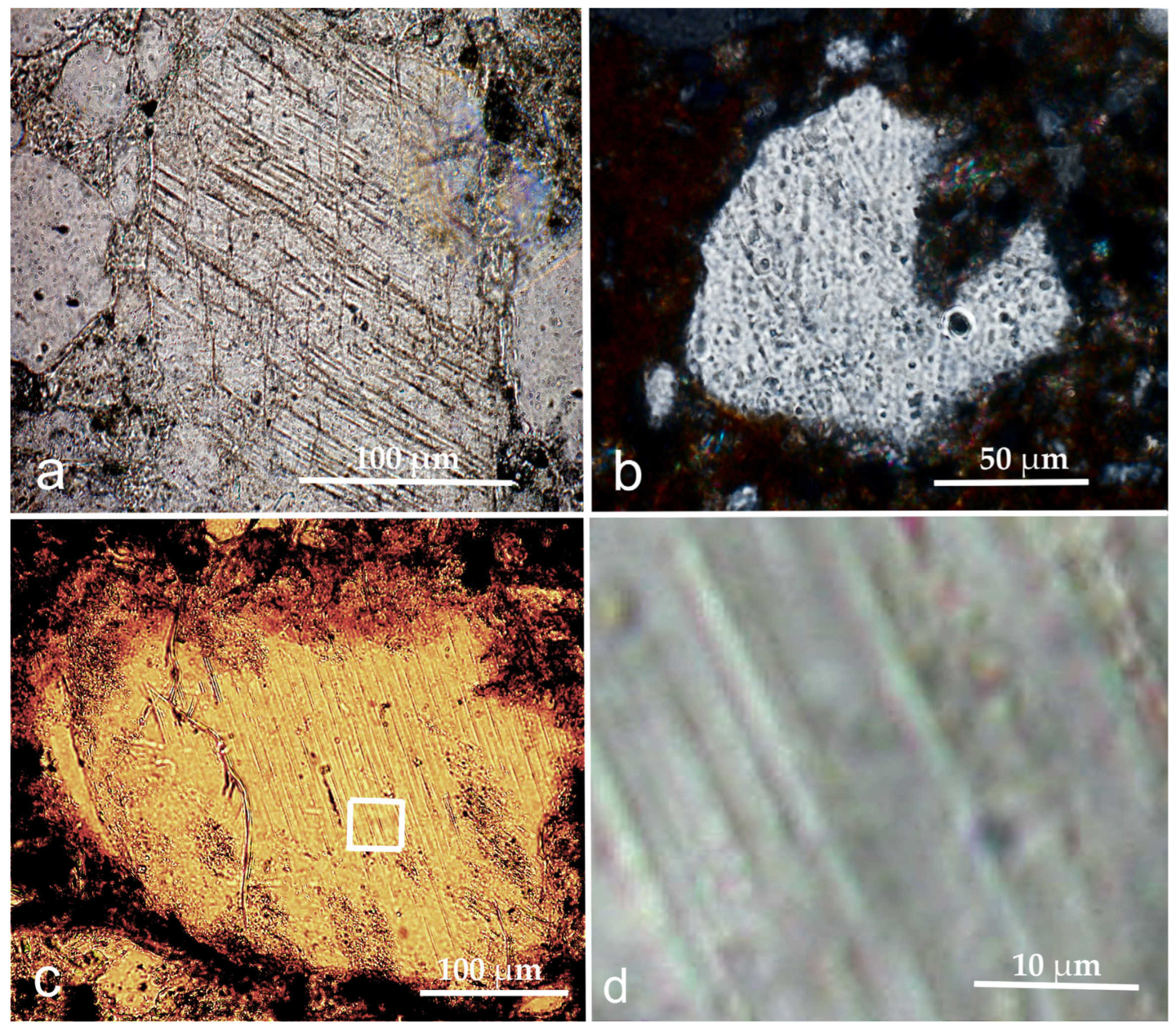
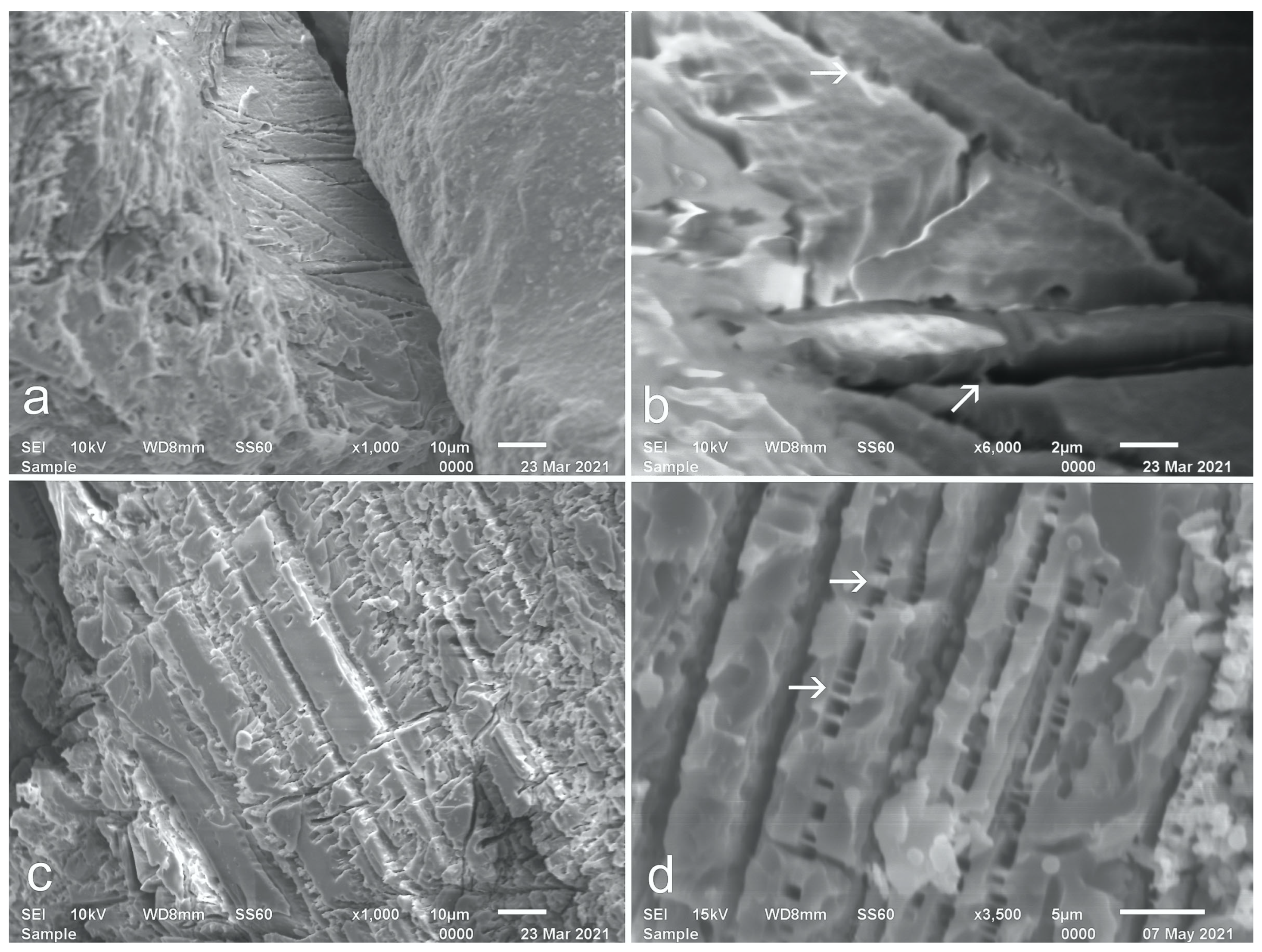
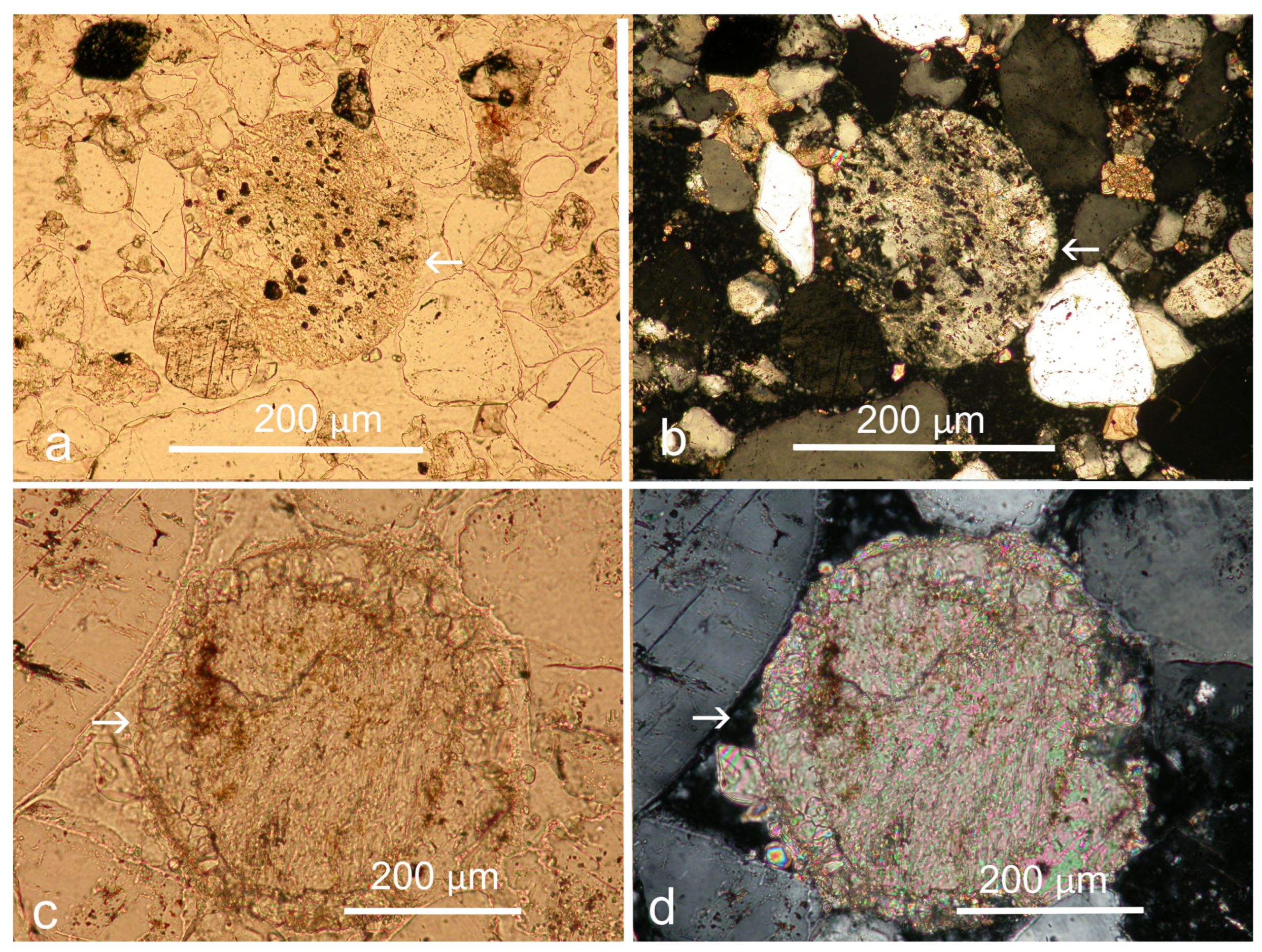
Disclaimer/Publisher’s Note: The statements, opinions and data contained in all publications are solely those of the individual author(s) and contributor(s) and not of MDPI and/or the editor(s). MDPI and/or the editor(s) disclaim responsibility for any injury to people or property resulting from any ideas, methods, instructions or products referred to in the content. |
© 2025 by the authors. Licensee MDPI, Basel, Switzerland. This article is an open access article distributed under the terms and conditions of the Creative Commons Attribution (CC BY) license (https://creativecommons.org/licenses/by/4.0/).
Share and Cite
Tanner, L.H.; Clutson, M.J.; Brown, D.E. Evidence of Ejecta from the Late-Triassic Manicouagan Impact in the Blomidon Formation, Fundy Basin, Canada. Geosciences 2025, 15, 400. https://doi.org/10.3390/geosciences15100400
Tanner LH, Clutson MJ, Brown DE. Evidence of Ejecta from the Late-Triassic Manicouagan Impact in the Blomidon Formation, Fundy Basin, Canada. Geosciences. 2025; 15(10):400. https://doi.org/10.3390/geosciences15100400
Chicago/Turabian StyleTanner, Lawrence H., Michael J. Clutson, and David E. Brown. 2025. "Evidence of Ejecta from the Late-Triassic Manicouagan Impact in the Blomidon Formation, Fundy Basin, Canada" Geosciences 15, no. 10: 400. https://doi.org/10.3390/geosciences15100400
APA StyleTanner, L. H., Clutson, M. J., & Brown, D. E. (2025). Evidence of Ejecta from the Late-Triassic Manicouagan Impact in the Blomidon Formation, Fundy Basin, Canada. Geosciences, 15(10), 400. https://doi.org/10.3390/geosciences15100400





